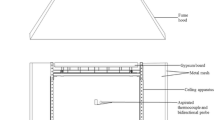Abstract
n-heptane pool fire and industrial alcohol pool fire in a ceiling vented compartment were studied experimentally. The parameters including mass loss rate and rate of gas temperature rise were investigated. The results suggest that the rate of gas temperature rise, whose variations were highly coincident with those of the mass loss rate, minimized at the moment of extinction. The correlation of the rate of average nondimensional temperature rise with mass loss rate was established. It was found that the rate of average nondimensional temperature rise may be correlated with mass loss rate via the gas heat absorption coefficient which was found to be a quadratic function of the nondimensional heat release rate for the ceiling vented compartment under study. The present study may be of practical use for estimation of the time-dependent changes in mass loss rate from the gas temperature curves.









Similar content being viewed by others
References
Karlsson B, Quintiere JG (2000) Enclosure fire dynamics. CRC Press, New York
Rangwala AS (2002) Mathematical modeling of low ventilation compartment fires. Master Thesis, University of Maryland, USA
Quintiere JG (2002) Fire behavior in building compartments. Proc Combust Inst 29:181–193
Utiskul Y, Quintiere JG, Rangwala AS et al (2005) Compartment fire phenomena under limited ventilation. Fire Saf J 40:367–390
Babrauskas V (1980) Estimating room flashover potential. Fire Technol 16:94–103
Li CH (2010) Experimental study on pool fire behaviors in closed compartment on ship. Doctoral Dissertation, University of Science and Technology of China, Hefei, China (in Chinese)
Chen B (2011) Experimental study on pool fire environment in ship room with ceiling vent. Doctoral Dissertation, University of Science and Technology of China, Hefei, China (in Chinese)
Chow WK (1999) New inspection criteria for flashover in compartmental fires. Fire Mater 23:13–15
Chen AP, Francis J, Dong XL et al (2011) An experimental study of the rate of gas temperature rise in enclosure fires. Fire Saf J 46:397–405
Cooper LY (1982) A mathematical model for estimating available safe egress time in fires. Fire Mater 6:135–144
Yamana T, Tanaka T (1985) Smoke control in large scale spaces. Fire Sci Technol 5:41–54
James AM (2002) Smoke management in covered malls and atria. In: DiNenno PJ, Drysdale D, Beyler CL et al., eds. The SFPE handbook of fire protection engineering, 3rd edn. National Fire Protection Association, Quincy
Li Q (2013) Experimental study on smoke properties in a ship room with ceiling vent. Doctoral Dissertation, University of Science and Technology of China, Hefei, China (in Chinese)
Yuan M (2013) Theoretical analysis and prediction of fire dynamics for pool fires in ceiling-vented compartments. Doctoral Dissertation, University of Science and Technology of China, Hefei, China (in Chinese)
He QZ (2011) Experimental study of the effect of horizontal opening size on pool fire characters in ship compartment. Bachelor thesis, University of Science and Technology of China, Hefei, China (in Chinese)
Zhang JQ, Lu SX, Li CH et al (2014) Fire-induced temperature correlations in ceiling vented compartments. Fire Technol 1–11. doi:10.1007/s10694-014-0386-5
Kang QS, Lu SX, Chen B (2010) Experimental study on burning rate of small scale heptane pool fires. Chin Sci Bull 55:973–979
Chen B, Lu SX, Li CH et al (2011) Initial fuel temperature effects on burning rate of pool fire. J Hazard Mater 188:369–374
Chen B, Lu SX, Li CH et al (2012) Unsteady burning of thin-layer pool fires. J Fire Sci 30:3–15
Sugawa O, Kawagoe K, Oka Y (1989) Burning behavior in a poorly-ventilated compartment fire-ghosting fire. Fire Sci Technol 9:5–14
Tu R (2012) Effects of low air pressure in high altitude area on pool fire burning behavior and flame image characteristics. Doctoral Dissertation. University of Science and Technology of China, Hefei, China (in Chinese)
Hu LH, Liu S, Wu L (2013) Flame radiation feedback to fuel surface in medium ethanol and heptane pool fires with cross air flow. Combust Flame 160:295–306
Hu LH, Tang F, Wang Q et al (2013) Burning characteristics of conduction-controlled rectangular hydrocarbon pool fires in a reduced pressure atmosphere at high altitude in Tibet. Fuel 111:298–304
De Ris J (1979) Fire radiation—a review. Proc Combust Inst 17:1003–1016
Babrauskas V (1983) Estimating large pool fire burning rates. Fire Technol 19:251–261
Nikitin YV (1999) Self-extinction of fire in a closed compartment. J Fire Sci 17:97–102
Cooper L, Harkleroad M, Quintiere JG et al (1982) An experimental study of upper hot layer stratification in full-scale multiroom fire scenarios. J Heat Transf 104:741–749
Mowrer FW (1999) Enclosure smoke filling revisited. Fire Saf J 33:93–114
Yuan M, Lu SX, Zhou Y et al (2014) A simplified mathematical model for predicting the vertical temperature profiles in enclosure fires without vertical opening. Fire Technol 50:929–943
He YP, Fernando A, Luo M (1998) Determination of interface height from measured parameter profile in enclosure fire experiment. Fire Saf J 31:19–38
Tewarson A (2002) Generation of heat and chemical compounds in fires. In: DiNenno PJ, Drysdale D, Beyler CL et al., eds. The SFPE handbook of fire protection engineering, 3rd edn. Quincy, National Fire Protection Association
Yuan M, Chen B, Li CH et al (2013) Analysis of the combustion efficiencies and heat release rates of pool fires in ceiling vented compartments. Procedia Eng 62:275–282
Acknowledgments
This work was supported by the Research Fund for the Doctoral Program of Higher Education of China (20123402110048 and 20123402120018) and the National Natural Science Foundation of China (51206157). The authors thank Bing Chen, Man Yuan, Qiang Li, Ran Tu, Jiaqing Zhang, Qize He, and Geraldine Carton for their help with the discussion.
Author information
Authors and Affiliations
Corresponding author
About this article
Cite this article
Chen, R., Lu, S., Zhang, B. et al. Correlation of rate of gas temperature rise with mass loss rate in a ceiling vented compartment. Chin. Sci. Bull. 59, 4559–4567 (2014). https://doi.org/10.1007/s11434-014-0479-z
Received:
Accepted:
Published:
Issue Date:
DOI: https://doi.org/10.1007/s11434-014-0479-z




